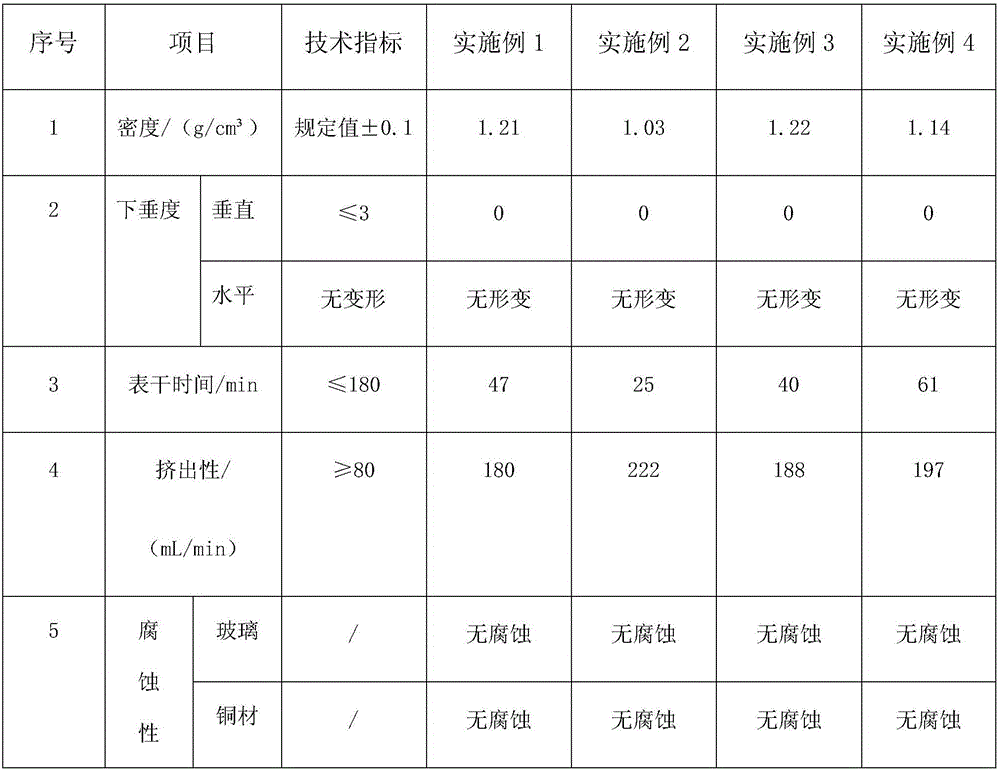Room-temperature curing ethyl lactate removal type silicone sealant
A silicone sealant, ethyl lactate technology, used in adhesives, adhesive additives, non-polymer adhesive additives, etc., can solve the problems of pungent, corrosive odor of cement substrates, and slow deep curing. , to achieve the effect of moderate curing speed and simple production process
- Summary
- Abstract
- Description
- Claims
- Application Information
AI Technical Summary
Problems solved by technology
Method used
Image
Examples
Embodiment 1
[0024] 40 parts of α,ω-dihydroxy polydimethylsiloxane with a viscosity of 20000mPa.s at 25°C and 60 parts of methyl polydimethylsiloxane with a viscosity of 350mPa.s at 25°C are pre-dried Add 170 parts of active nano-calcium carbonate into the kneader and heat up to 110°C to 120°C, knead for 1.5 hours under the condition of vacuum degree of -0.09MPa, then cool down to room temperature, transfer the above materials to the planetary mixer, and then add methyl 13 parts of ethyl trilactate silane, 5 parts of 3-aminopropyltriethoxysilane, 0.3 part of dibutyltin dilaurate, mixed for 40 minutes at a vacuum degree of -0.09MPa and a speed of 35rpm to obtain a room temperature curing Ethyl lactate type silicone sealant (see Table 1 for performance test results).
Embodiment 2
[0026] 60 parts of α, ω-dihydroxy polydimethylsiloxane with a viscosity of 80000mPa.s at 25°C and 55 parts of methyl polydimethylsiloxane with a viscosity of 100mPa.s at 25°C are pre-dried Add 98 parts of active nano-calcium carbonate into the kneader and raise the temperature to 110°C~120°C, knead for 1.5 hours under the condition of vacuum degree of -0.09MPa, then cool down to room temperature, transfer the above materials to the planetary mixer, and then add vinyl 15 parts of ethyl trilactate silane, 7 parts of 3-aminopropyltriethoxysilane, 0.5 part of dibutyltin dilaurate, mixed for 40 minutes at a vacuum degree of -0.09MPa and a speed of 35rpm to prepare a room temperature curing Ethyl lactate type silicone sealant (see Table 1 for performance test results).
Embodiment 3
[0028] 40 parts of α, ω-dihydroxy polydimethylsiloxane with a viscosity of 20000mPa.s at 25°C and 60 parts of methyl polydimethylsiloxane with a viscosity of 100mPa.s at 25°C are pre-dried Add 170 parts of active nano-calcium carbonate into the kneader and heat up to 110°C to 120°C, knead for 1.5 hours under the condition of vacuum degree of -0.09MPa, then cool down to room temperature, transfer the above materials to the planetary mixer, add methyl 8 parts of ethyl trilactate silane, 5 parts of vinyl trilactate ethyl silane, 5 parts of 3-aminopropyltriethoxysilane, 0.3 part of dibutyltin dilaurate, at a vacuum degree of -0.09MPa, at a speed of 35rpm After mixing for 40 minutes under the same conditions, a room temperature curing delactate type silicone sealant was prepared (see Table 1 for performance test results).
PUM
| Property | Measurement | Unit |
|---|---|---|
| Viscosity | aaaaa | aaaaa |
| Viscosity | aaaaa | aaaaa |
| Viscosity | aaaaa | aaaaa |
Abstract
Description
Claims
Application Information
 Login to View More
Login to View More - R&D
- Intellectual Property
- Life Sciences
- Materials
- Tech Scout
- Unparalleled Data Quality
- Higher Quality Content
- 60% Fewer Hallucinations
Browse by: Latest US Patents, China's latest patents, Technical Efficacy Thesaurus, Application Domain, Technology Topic, Popular Technical Reports.
© 2025 PatSnap. All rights reserved.Legal|Privacy policy|Modern Slavery Act Transparency Statement|Sitemap|About US| Contact US: help@patsnap.com



